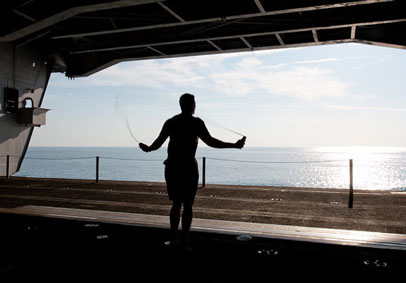Life at sea can be difficult when it comes to maintaining your fitness. Your workout options might be more limited than for your land-based buddies—you can’t always pick up a sandbag in the middle of the ocean. But with the help of a planning app and some creativity, you can get in a good sweat daily.
For starters, visit the Navy Operational Fitness & Fueling System (NOFFS), which was developed specifically for maintaining fitness underway. A few of the different training series are based on ship type (submarine, large deck, and surface ship), as well as fitness goals (strength, endurance, and sandbag). Each series contains a periodized workout plan using equipment that’s common on Navy ships.
If you’re a Coastie with limited equipment options, the NOFFS Submarine Series could work well for you. It was designed to be performed in small spaces and with minimal equipment.
Once you choose the type of training series you want, write out your SMART goals and create your workouts accordingly. If you want to get bigger and stronger, you’ll want to train for muscular strength, which means lifting heavier weights for fewer repetitions (think 6 reps of at least 80–85% of your 1RM). If you want to max your fitness test, that will require muscular endurance, meaning lighter weights with more reps (12–15 reps of no more than 67% of your 1RM). Pick the NOFFS program that best matches your goals, or create your own.
If you have limited equipment, keep in mind you can still get some strength training using light- or bodyweight exercises. Ultimately though, you’ll need to add more weight in your land-based gym to really see big gains.
Maintaining your cardio aboard ship also can be difficult. Check to see if your boat has treadmills, ellipticals, or stationary bikes. If it doesn’t and you have a flight deck, you can run laps or sprints on the deck. Beware, though, because the nonskid surface on some flight decks can take a toll on your sneakers, which could mean you have to replace them sooner. As a last resort for more confined ship types, high-intensity bodyweight circuits can get your lungs burning in all the right ways.
